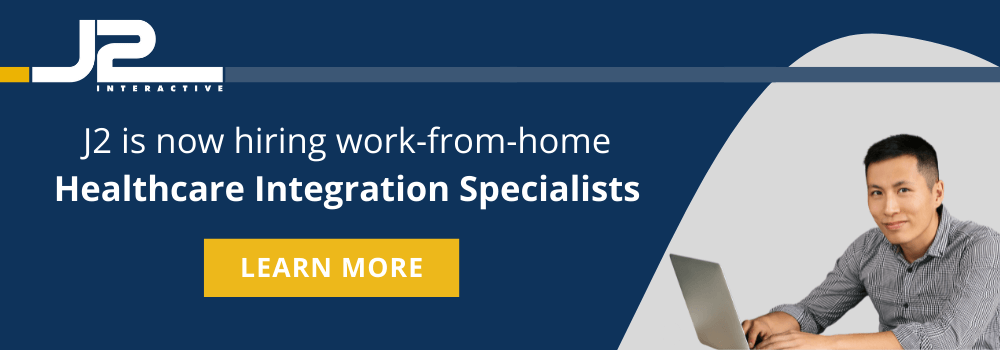Accelerated by the pandemic and powered by advancements in available technology, we have seen a rapid advancement in remote healthcare over the last several years.
These advances have been possible due to the combination of high-speed internet, more robust healthcare software platforms, and better interoperability among platforms.

Beyond just televisits, remote healthcare lets providers manage various conditions without patients leaving their homes to visit a doctor’s office or hospital physically.
A few of the many benefits to the patient are:
- Decreased travel costs
- Increased convenience and flexibility
- Greater privacy
- Reduced risk of infection
- Better outcomes
Connected health generally improves the patient experience.
We will first look at several remote, online healthcare types: hospital-at-home, health-at-home, remote patient monitoring, and telehealth. Then, we’ll look at some technologies that have made improvements possible.
There are many job opportunities in remote healthcare — both on the caregiving and technology sides.
1. Hospital-at-home
In the United States, Hospital-at-Home® is a program and a registered service mark of The Johns Hopkins University non-profit corporation.
According to Johns Hopkins, “Hospital-at-home enable some patients who need acute-level care to receive care in their homes, rather than in a hospital. This care delivery model has been shown to reduce costs, improve outcomes and enhance the patient experience.”
The program has been implemented by VA hospitals, health systems, managed care programs, and home care providers to treat older adults with acute illnesses cost-effectively.
According to a 2005 study, “the hospital-at-home care model is feasible, safe, and efficacious for certain older patients with selected acute medical illnesses who require acute hospital-level care.”
2. Health-at-home
Health-at-home, a.k.a. home healthcare, is a broader category than hospital-at-home.
The range of health-at-home services includes nursing, medical & social work, physical & occupational therapy, and speech therapy. Patients can also be assisted with personal care, such as bathing and dressing.
The idea is to provide the exact skills available in a clinical setting — but in a home setting.
Home health care helps patients return to normal activities by providing living assistance and in-home medical care.
Nurses offer the same skills they provide at a hospital but at the patient’s home. Family members become engaged in home treatment processes and therefore learn from staff how they can assist in caring for the patient.
3. Home infusion therapy
Home infusion therapy can be more convenient for patients and often less expensive than hospital-based infusion therapy.
Home infusion therapy requires planning and coordination between the patient, their caregiver, and the home infusion pharmacy.
Home infusion therapy requires special equipment, including an infusion pump and sterile supplies.
4. Telehealth
Telehealth is the broadest category of remote health.
While there is no consistent definition, telehealth is generally when healthcare providers care for patients without an in-person office visit.
Telehealth is primarily delivered online via a computer, tablet, or smartphone — although, in some jurisdictions, a standard phone call qualifies as telehealth.
The Center for Connected Health Policy (CCHP) has defined four telehealth modalities. They are live video, store-and-forward, remote patient monitoring, and mobile health.
Store-and-forward means a caregiver can record a video and send a patient a link for later viewing. Mobile health, or mHealth, can include the use of mobile apps.
5. Remote patient monitoring
Remote patient monitoring (RPM), which the CCHP includes as part of telehealth, is the use of technology to collect medical data from patients in their homes and transmit it to healthcare providers for assessment and follow-up.
RPM can be used to monitor various health conditions, including diabetes, heart disease, and respiratory disease.
The technology includes devices that measure vital signs, such as blood pressure and heart rate, and devices that monitor blood sugar levels, weight, and activity levels. Data is transmitted to healthcare providers through a secure, HIPAA-compliant platform.
Remote patient monitoring can improve patient outcomes by allowing for earlier detection and treatment of problems and reducing hospitalizations and ED visits.
RPM can also save money by reducing the need for office visits and other healthcare services. These platforms also provide patients access to their data, educational materials, and other resources.
Patients can use the information to make lifestyle choices that improve their health.
6. Care coordination hubs
Care coordination hubs are for chronic care or high-touch, high-cost patients. These hubs are staffed with skilled professionals who help patients coordinate their care and connect them with resources.
They provide patients with information and support to help them make informed decisions about their healthcare.
Enabling Software Platforms
These remote healthcare modalities all require enabling technology on some level.
The delivery of solutions is often a combination of one or more vendor platforms plus outsourced or in-house delivery teams.
Two of the top software vendors that provide enabling technologies are Salesforce and InterSystems. Both companies have had the Leader position in one of the Gartner Magic Quadrants. For certain applications, these two platforms work in conjunction with one another.
Salesforce
Salesforce is a $7.7 billion company that provides a wide range of industry solutions, including many for healthcare.
Components of the Salesforce platform include:
- Salesforce Health Cloud
- Salesforce Marketing Cloud
- Salesforce Experience Cloud (for patient portals)
- Salesforce Service Cloud
- Salesforce Field Service
Various ‘clouds’ can be included in a rollout as needed. For example, Salesforce Field Service can schedule and dispatch caregiver home visits.
InterSystems
InterSystems is the engine behind many vital applications in healthcare and other global industries.
InterSystem believes software should be interoperable, reliable, intuitive, and scalable. The company builds platforms and solutions designed to drive better decisions, actions, and outcomes for the people who stake their lives and livelihoods on InterSystems’ technology.
InterSystems products include
- HealthShare – A suite of solutions that work together to capture information, share it in a meaningful way, aid understanding and drive transformative action across organizations and communities.
- InterSystems IRIS – A cloud-first data platform for high-performance applications
- InterSystems IRIS for Health – A highly scalable healthcare data management platform for health and life sciences solutions
- TrakCare – More than an electronic medical record: A unified health information system
If you are seeking employment, many jobs are available in remote healthcare. J2 currently has job opportunities for InterSystems Caché / Ensemble / HealthShare developers.




